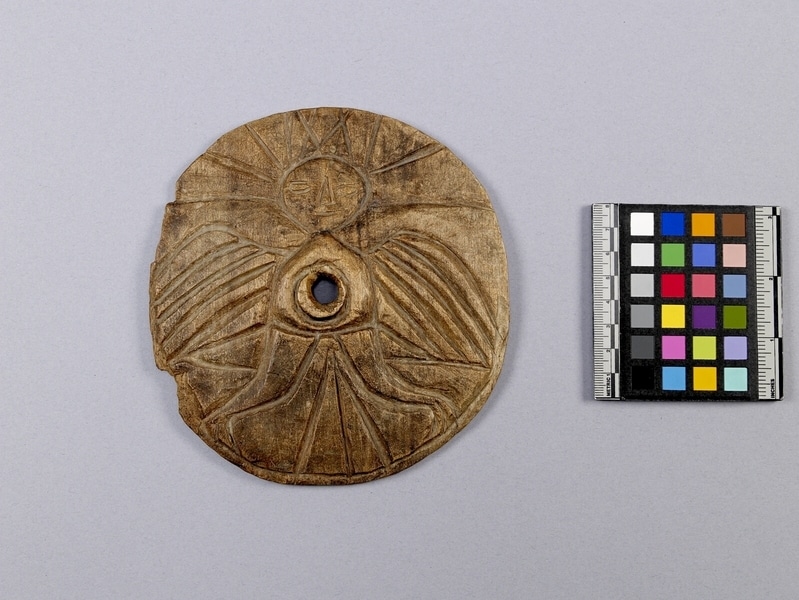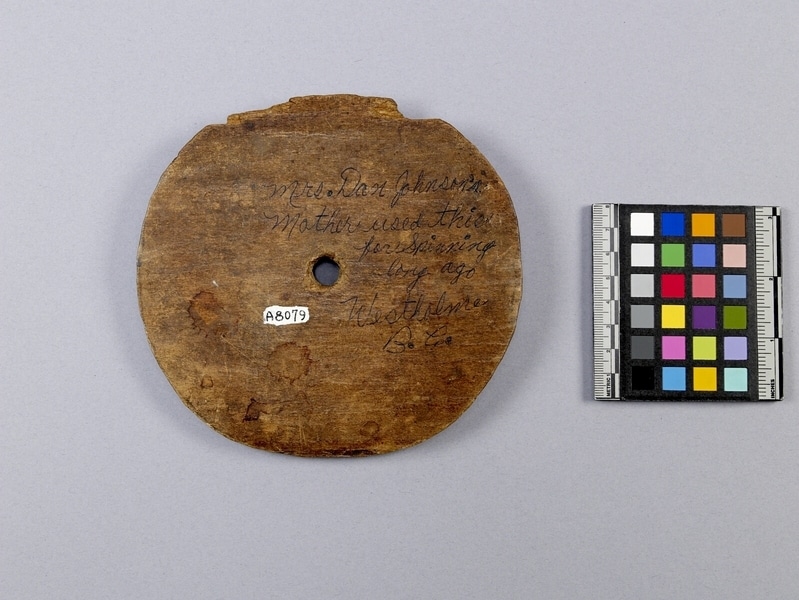Spindle Whorl Item Number: A8079 from the MOA: University of British Columbia


Description
Spindle whorl comprised of a round, wooden disc with a small hole in its centre. Flat dorsal surface and slightly convex ventral surface. The convex surface is engraved with an anthropomorphic bird figure with lines radiating from around its body. The head and torso are human-like, but the legs and wings are bird-like.
History Of Use
Spindle whorls are used in the spinning of wool. Homer Barnett (1955) notes that spindle whorls used by the southern Coast Salish of British Columbia are larger than those used in the north, with a shaft that is twice as long as the whorl. In the north, fibres were spun on smaller whorls that were "twirled between the leg and palm (1955:118)." By contrast, whorls such as this one were used to spin fibres that were suspended from overhead. This arrangement created a tension in the roving. Johnson and Bernick (1986) report that traditionally several different techniques were used for turning the spindle, however, contemporary weavers now make use of a spinning machine that is similar in appearance to a treadle sewing machine.
Cultural Context
weaving; spinning; guardian spirit complex
Specific Techniques
Michael Kew (1980) notes that spindle whorls are typically engraved, with many exhibiting an advanced wood working technique known as block engraving in which the figures are raised and details are added with sharply incised lines and other stylized elements. Design elements, such as human figures are often done in low relief. Animals are portrayed with blunt noses and birds have straight edges to their wings. The designs are outlined on a flat surface and then given depth through incising.
Narrative
The back of the piece has the following written in black ink: "Mrs. Dan Johnson's mother used this for spinning long ago Westholme B.C."
Iconographic Meaning
Bird designs are commonly found on objects, specifically spindle whorls, from the Cowichan area. The meanings behind the human-bird figure represented on this particular spindle whorl, however, are hard to decipher. Anthropologists Michael Kew (1980) and Wayne Suttles (1987) suggest that the images that adorn Coast Salish material culture are representative of an elaborate guardian spirit complex in which animals play a prominent role and are associated with various supernatural gifts.
Item History
- Made in Westholme, British Columbia, Canada
- Owned by Mrs. Dan Johnston
- Owned by Edith Bevan Cross before July 30, 1962
- Received from Edith Bevan Cross (Seller) and H. R. MacMillan (Funding source) on July 30, 1962
What
- Name
- Spindle Whorl
- Identification Number
- A8079
- Type of Item
- spindle whorl
- Material
- alder wood
- Manufacturing Technique
- carved and engraved
- Overall
- height 1.8 cm, width 14.9 cm, depth 15.7 cm
Who
- Culture
- Coast Salish: Quwutsun'
- Previous Owner
- Mrs. Dan Johnston and Edith Bevan Cross
- Received from
- Edith Bevan Cross (Seller) and H. R. MacMillan (Funding source)
Where
- Holding Institution
- MOA: University of British Columbia
- Made in
- Westholme, British Columbia, Canada
When
- Ownership Date
- before July 30, 1962
- Acquisition Date
- on July 30, 1962
Other
- Condition
- fair
- Current Location
- Case 2
- Accession Number
- 0081/0032